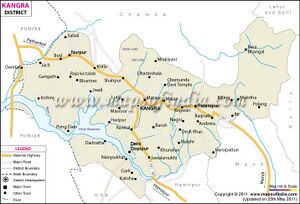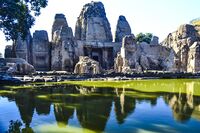Masrur
| Author:Laxman Burdak, IFS (R) |

Masrur (मसरूर) is village in Dera Gopipur tahsil of district Kangra in Himachal Pradesh.
Variants
Location
Jat Gotras
Population
History
Masrur Temples
The Masrur Temples, also referred to as Masroor Temples or Rock-cut Temples at Masrur, is an early 8th-century complex of rock-cut Hindu temples in the Kangra Valley of Beas River in Himachal Pradesh, India.[1] The temples face northeast, towards the Dhauladhar range of the Himalayas.[2] They are a version of North Indian Nagara architecture style, dedicated to Shiva, Vishnu, Devi and Saura traditions of Hinduism, with its surviving iconography likely inspired by a henotheistic framework.
Though a major temples complex in the surviving form, the archaeological studies suggest that the artists and architects had a far more ambitious plan and the complex remains incomplete. Much of the Masrur's temple's sculpture and reliefs have been lost. They were also quite damaged, most likely from earthquakes.[3]
The temples were carved out of monolithic rock with a shikhara, and provided with a sacred pool of water as recommended by Hindu texts on temple architecture.[4] The temple has three entrances on its northeast, southeast and northwest side, two of which are incomplete. Evidence suggests that a fourth entrance was planned and started but left mostly incomplete, something acknowledged by the early 20th-century colonial era archaeology teams but ignored leading to misidentification and erroneous reports.[5]The entire complex is symmetrically laid out on a square grid, where the main temple is surrounded by smaller temples in a mandala pattern. The main sanctum of the temples complex has a square plan, as do other shrines and the mandapa. The temples complex features reliefs of major Vedic and Puranic gods and goddesses, and its friezes narrate legends from the Hindu texts.[6]
The temple complex was first reported by Henry Shuttleworth in 1913 bringing it to the attention of archaeologists.[3] They were independently surveyed by Harold Hargreaves of the Archaeological Survey of India in 1915. According to Michael Meister, an art historian and a professor specializing in Indian temple architecture, the Masrur temples are a surviving example of a temple mountain-style Hindu architecture which embodies the earth and mountains around it.[7]
मसरूर

मसरूर: मसरूर मंदिर मसरूर रॉक कट मंदिर काँगड़ा जिले में स्थित एक जटिल मंदिर है, जो कांगड़ा शहर से 40 किलोमीटर दूर पश्चिम में है। यह अब ‘ठाकुरवाड़ा’ के नाम से जाना जाता है, जिसका अर्थ है “वैष्णव मंदिर। यह शास्त्रीय भारतीय वास्तुकला शैली की शिखर (स्थापना का टॉवर) शैली में, पत्थर के चट्टानों के कालीन मंदिरों का एक परिसर है, जो कि कला इतिहासकारों द्वारा 6-8 वीं शताब्दियों तक दर्ज किया गया था। भारत में कई जगह हैं जहां रॉक-कट स्ट्रक्चर मौजूद हैं परन्तु ऐसा एक वास्तुशिल्प मंदिर उत्तरी भाग के लिए अद्वितीय है भारत के पश्चिमी और दक्षिणी में इस इमारत के सामने मसरूर झील है, जिसमे मंदिर का प्रतिबिम्ब दिखता है। माना जाता है कि इस मंदिर का निर्माण पांडवों द्वारा अपने अज्ञातवास के दोरान किया था। कहा जाता है कि मंदिरों के सामने झील को पांडवों ने अपनी पत्नी द्रोपदी के लिए बनवाया गया था। कांगड़ा जिला में चट्टान को काट कर पहाड़ की चोटी पर बने इन मंदिरों को सर्वप्रथम 1913 में एक अंग्रेज एचएल स्टलबर्थ ने खोजा था। यहां कुल 15 मंदिर समूह हैं। मुख्य मंदिर को ठाकुरद्वारा कहा जाता है और इसमें तीन राम, लक्ष्मण और सीता की पत्थर की मूर्तियां हैं
Notable persons
External links
References
- ↑ Laxman S. Thakur (1996). The Architectural Heritage of Himachal Pradesh: Origin and Development of Temple Styles. Munshiram Manoharlal. pp. 27, 39–43. ISBN 978-81-215-0712-7.
- ↑ Michael W. Meister (2006), Mountain Temples and Temple-Mountains: Masrur, Journal of the Society of Architectural Historians, Vol. 65, No. 1 (Mar., 2006), University of California Press, pp. 26- 49
- ↑ Michael W. Meister (2006), Mountain Temples and Temple-Mountains: Masrur, Journal of the Society of Architectural Historians, Vol. 65, No. 1 (Mar., 2006), University of California Press, pp. 26- 49
- ↑ Michael W. Meister (2006), Mountain Temples and Temple-Mountains: Masrur, Journal of the Society of Architectural Historians, Vol. 65, No. 1 (Mar., 2006), University of California Press, pp. 26- 49
- ↑ Michael W. Meister (2006), Mountain Temples and Temple-Mountains: Masrur, Journal of the Society of Architectural Historians, Vol. 65, No. 1 (Mar., 2006), University of California Press, pp. 26- 49
- ↑ Michael W. Meister (2006), Mountain Temples and Temple-Mountains: Masrur, Journal of the Society of Architectural Historians, Vol. 65, No. 1 (Mar., 2006), University of California Press, pp. 26- 49
- ↑ Michael W. Meister (2006), Mountain Temples and Temple-Mountains: Masrur, Journal of the Society of Architectural Historians, Vol. 65, No. 1 (Mar., 2006), University of California Press, pp. 26- 49

